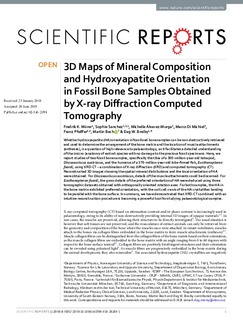| dc.contributor.author | Mürer, Fredrik Kristoffer | |
| dc.contributor.author | Sanchez, Sophie | |
| dc.contributor.author | Alvarez-Murga, Michelle | |
| dc.contributor.author | Di Michiel, Marco | |
| dc.contributor.author | Pfeiffer, Franz | |
| dc.contributor.author | Bech, Martin | |
| dc.contributor.author | Breiby, Dag Werner | |
| dc.date.accessioned | 2019-03-04T09:31:35Z | |
| dc.date.available | 2019-03-04T09:31:35Z | |
| dc.date.created | 2018-07-03T12:23:38Z | |
| dc.date.issued | 2018 | |
| dc.identifier.issn | 2045-2322 | |
| dc.identifier.uri | http://hdl.handle.net/11250/2588407 | |
| dc.description.abstract | Whether hydroxyapatite (HA) orientation in fossilised bone samples can be non-destructively retrieved and used to determine the arrangement of the bone matrix and the location of muscle attachments (entheses), is a question of high relevance to palaeontology, as it facilitates a detailed understanding of the (micro-)anatomy of extinct species with no damage to the precious fossil specimens. Here, we report studies of two fossil bone samples, specifically the tibia of a 300-million-year-old tetrapod, Discosauriscus austriacus, and the humerus of a 370-million-year-old lobe-finned fish, Eusthenopteron foordi, using XRD-CT – a combination of X-ray diffraction (XRD) and computed tomography (CT). Reconstructed 3D images showing the spatial mineral distributions and the local orientation of HA were obtained. For Discosauriscus austriacus, details of the muscle attachments could be discerned. For Eusthenopteron foordi, the gross details of the preferred orientation of HA were deduced using three tomographic datasets obtained with orthogonally oriented rotation axes. For both samples, the HA in the bone matrix exhibited preferred orientation, with the unit cell c-axis of the HA crystallites tending to be parallel with the bone surface. In summary, we have demonstrated that XRD-CT combined with an intuitive reconstruction procedure is becoming a powerful tool for studying palaeontological samples. | nb_NO |
| dc.language.iso | eng | nb_NO |
| dc.publisher | Nature Research | nb_NO |
| dc.rights | Navngivelse 4.0 Internasjonal | * |
| dc.rights.uri | http://creativecommons.org/licenses/by/4.0/deed.no | * |
| dc.title | 3D Maps of Mineral Composition and Hydroxyapatite Orientation in Fossil Bone Samples Obtained by X-ray Diffraction Computed Tomography | nb_NO |
| dc.type | Journal article | nb_NO |
| dc.type | Peer reviewed | nb_NO |
| dc.description.version | publishedVersion | nb_NO |
| dc.source.volume | 8 | nb_NO |
| dc.source.journal | Scientific Reports | nb_NO |
| dc.source.issue | 1 | nb_NO |
| dc.identifier.doi | 10.1038/s41598-018-28269-1 | |
| dc.identifier.cristin | 1595407 | |
| dc.relation.project | Norges forskningsråd: 275182 | nb_NO |
| dc.relation.project | Norges forskningsråd: 272248 | nb_NO |
| dc.description.localcode | © The Author(s) 2018. This article is distributed under the terms of the Creative Commons Attribution 4.0 International License (http://creativecommons.org/licenses/by/4.0/) | nb_NO |
| cristin.unitcode | 194,66,20,0 | |
| cristin.unitname | Institutt for fysikk | |
| cristin.ispublished | true | |
| cristin.fulltext | original | |
| cristin.qualitycode | 1 | |

